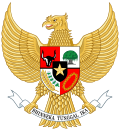| People's Democratic Front | |
|---|---|
| Front Demokrasi Rakjat | |
 | |
| Leader | Amir Sjarifuddin |
| Foundation | February 1948 |
| Dissolved | December 1948 |
| Merger of | |
| Country | Indonesia |
| Allegiance | Soviet Republic of Indonesia
|
| Headquarters | Surakarta (February ‒ September 1948) Madiun (September ‒ December 1948) |
| Ideology | |
| Political position | Far-left |
| Opponents | |
| Battles and wars | Madiun Affair |
| This article is part of a series on the |
| Politics of Indonesia |
|---|
 |
People's Democratic Front (Indonesian : Front Demokrasi Rakjat, FDR) was a short-lived united front of leftists in Indonesia, founded in February 1948. [1] [2] FDR included the Communist Party of Indonesia, the Socialist Party, Labour Party of Indonesia, SOBSI and Pesindo. [3] [4] The leader of FDR was Amir Sjarifuddin. [5]